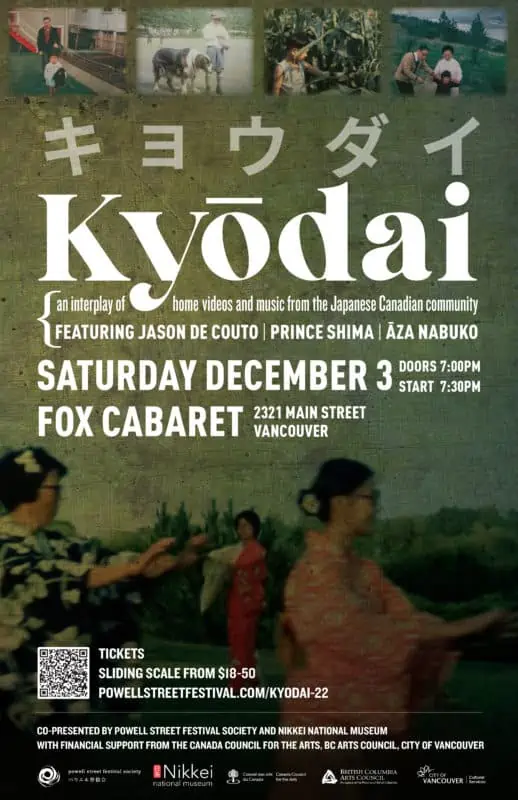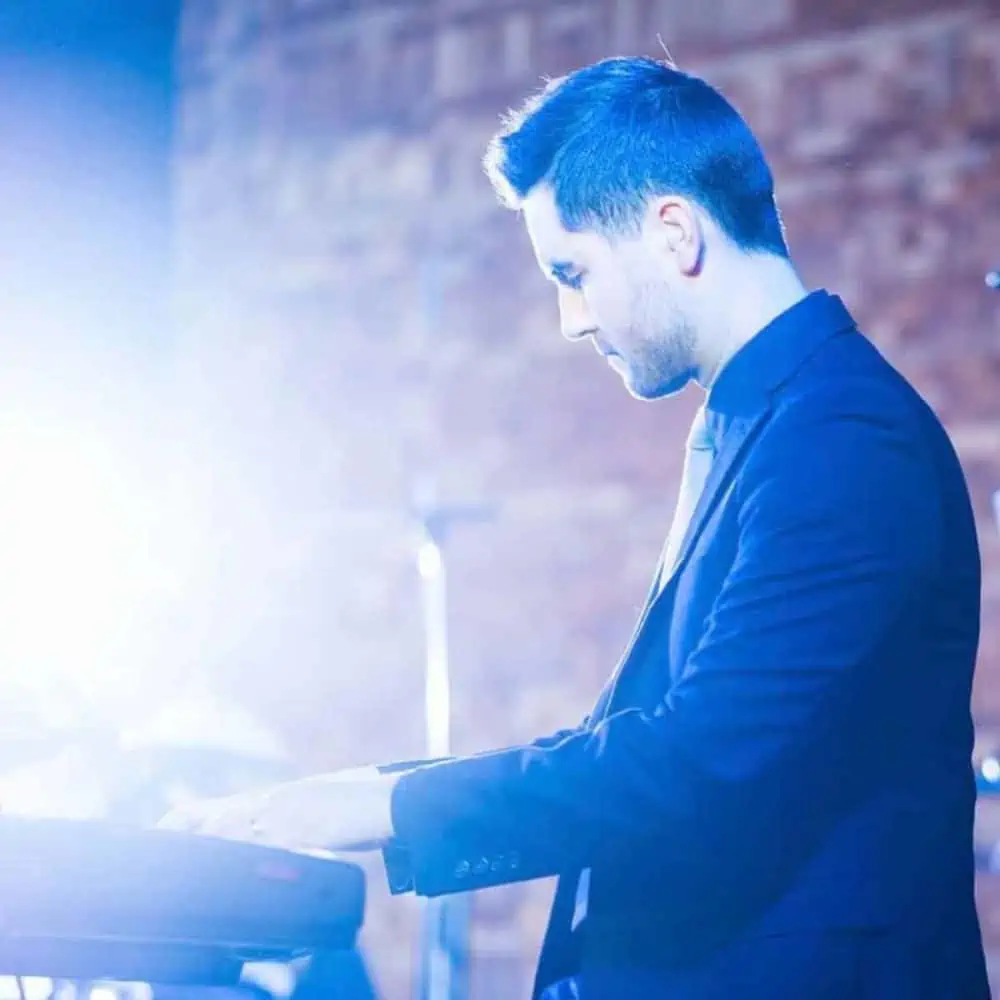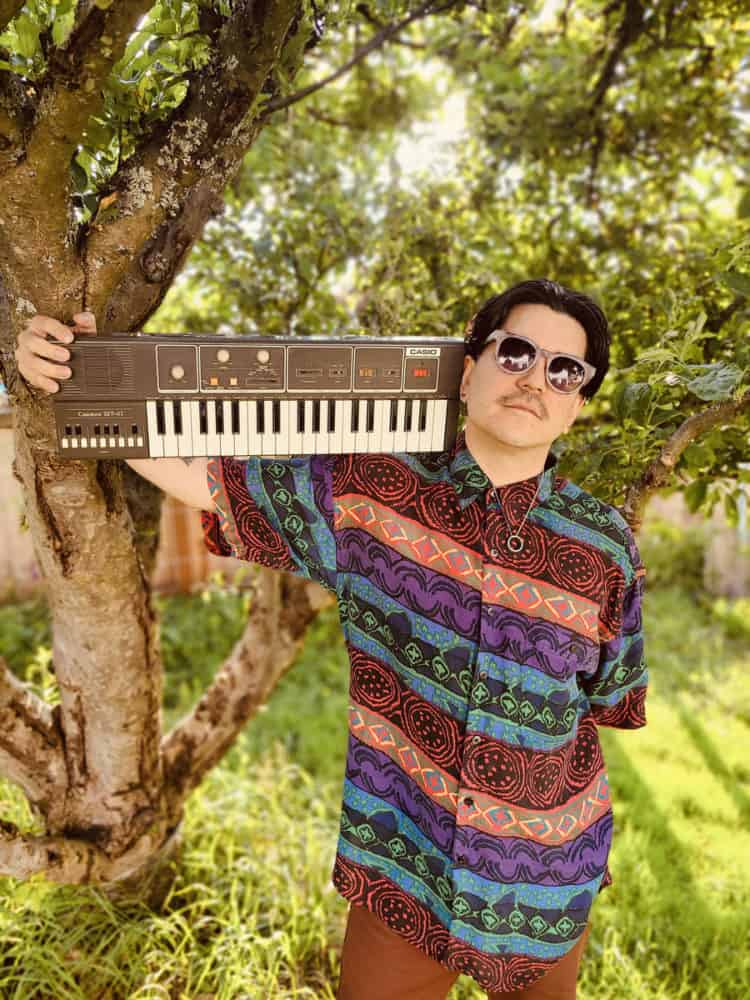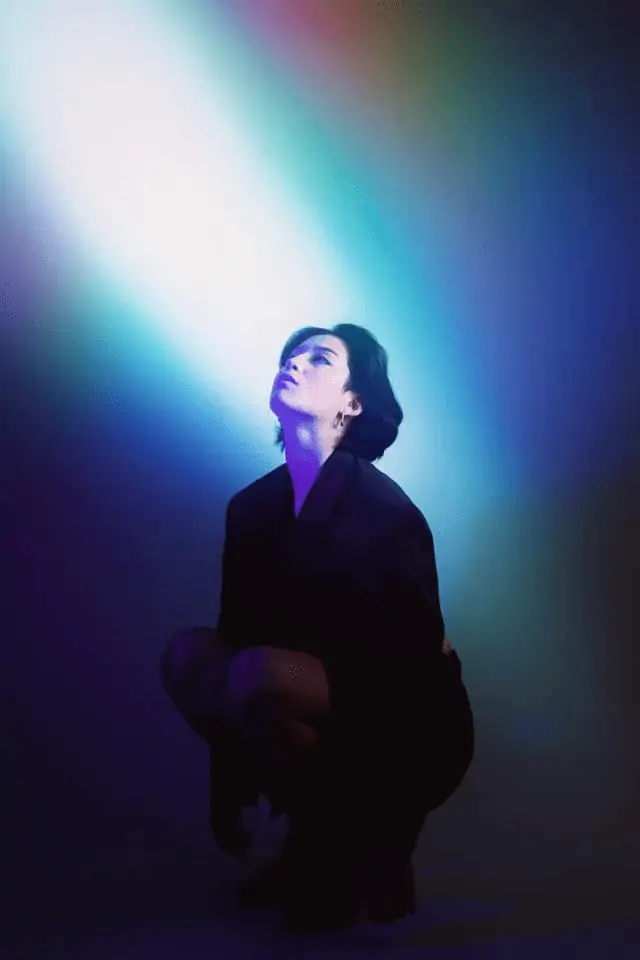Kyōdai

An interplay of home videos and music from the Japanese Canadian Community
December 3, 2022 at 7:30 PM (Doors 7:00 PM)
The Fox Cabaret 2321 Main St. at 7th Ave., Vancouver
LIVE Online
Tickets: Sliding-Scale from $18 (plus processing fees). Buy Now
Witness Japanese Canadian musicians Jason de Couto, Prince Shima, and Āza Nabuko in a multi-sensory concert experience in collaboration with Powell Street Festival Society and the Nikkei National Museum and Cultural Centre. Join us at the Fox Cabaret as these musicians explore the theme of kyōdai (siblings) through the lens of curated, sought-after home videos from pre, during, and post incarceration, produced by artist and video archivist Jeffery Chong. Kyōdai acts as a rallying call to embrace our heritage, deepen communal bonds, and reveal what’s known and unknown about our relationships past, present, and future.
Also at the event, get your hands on some very special, limited-edition Powell Street Festival winter merchandise and chat with friends from the festival over from the Fox’s bar. Kyōdai will also be live streamed online, so you can take part in this one-of-a-kind sonic and visual experience from anywhere!
In-Person Tickets
Tickets for this event are available on a sliding scale from $18-$50 (plus processing fees), please choose an amount you are comfortable with and enjoy the performance. All tickets are general admission, and will be held at the door. 19+. Thank you for your support!
Online Livestream Tickets
Tickets for this event are available on a sliding scale from $18-$50 (plus processing fees), please choose an amount you are comfortable with and enjoy the performance. Once purchased, you will receive an email from Eventbrite with a link to access the stream on our online event page, please tune in just before 7:30 PM Pacific time. Make sure to use an email you can check, and to look in your junk/spam folder for this confirmation. You can also find the stream by logging-in to your account on eventbrite.ca.
Please note that a recording will not be made available after the event. Thank you for your support!
Accessibility and Content Warnings
The Fox Cabaret is wheelchair accessible. Kyōdai takes place in the cabaret room, accessible through a ramped entrance. The Fox also has a wheelchair accessible washroom in the space.
The Fox Cabaret is a bar and nightclub space with dim lighting.
About the Artists

Jason de Couto is a Vancouver based musician focused primarily on piano and keyboards. He works with a variety of musicians, ensembles, and multi-disciplinary artists in an array of styles and genres. He holds degrees from UBC, SFU and Capilano University, and is currently also a music teacher working in the Vancouver School District.

Prince Shima (Bradley Kurushima) is a third generation Japanese Canadian settler based on Vancouver Island. He is a multi-instrumentalist, composer and producer working in the spaces between art-pop and experimental ambient music. He combines analog and digital instruments to create otherworldly landscapes, with the aim of making transportative and transformative music.

Based in Vancouver BC, multi instrumentalist Āza Nabuko is already making waves in the music industry. Landing a sync placement with Netflix’s ‘Tiny Pretty Things’ and a spot in the top 100 in CBC Searchlight for 2020, the industry is just starting to get to know Āza Nabuko. Her style is at the junction of genres that express tones of chill-out indie and powerful pop / alternative vibes. Aza’s debut EP was released by JumpAttack! Records in July of 2019. Her first full length album ‘Indigo’ has been released since. The honesty in Aza’s music comes from personal experience and understanding, writing for expression and for those who need to hear.
Jeffery Chong works with time-based media and photography. His practice is informed by his work as an archival film conservation technician specializing in preserving home movies. His films have exhibited across North America. Jeffery lives and works on the unceded territories of the Musqueam, Squamish and Tsleil-Waututh peoples.
Video Information and Collections Metadata
For more information on the Nikkei National Museum and Cultural Centre’s Moving Image Collection, enter one of the article numbers on their website. See more from them on their YouTube Channel
Jason de Couto's Set
These archival films document Japanese Canadian life from approximately 1920 to 1940, before the community’s forced dispossession, relocation and incarceration in 1942. These films highlight their presence, leisure, livelihood, and freedom of mobility on the west coast.
The first part takes place at the Shaughnessy neighbourhood home of the Consulate General of Japan, Powell Grounds (Oppenheimer Park), the Japanese Canadian War Memorial in Stanley Park, Lynn Creek in North Vancouver, and Royston on Vancouver Island. Identified are Kannosuke Kaminishi, his wife Kayano (née Takehara), his dog Queenie, Sato San, and the Miyaki, Nishimura, and Minato families. Concluding are the Tomojiro Inouye home movies in Mayo (now Paldi), near Duncan, BC. Identified within these scenes are members of the Inouye family, including Josuke, Sanaye, Tomojiro and Tomi (née Takayama), Saiji, Masaru, Shoji, Takeshi, Sumiko Kamachi (née Inouye), Eiji and Yumi, Akira, and family friend Masanobu Kawahira.
The next part are excerpts from a film from the Shigetaka (Steve) Sasaki Family fonds, and documents the visit of Prince and Princess Chichibu. They were representatives of Japan en route to attend King George VI’s coronation in 1937. This reel features the Japanese Hall on Alexander Street, a bird’s-eye view of Powell Street, and hundreds of fishing boats from Steveston. Next are 1920s films from the Kaye Kaminishi collection documenting numerous visits to Japan. Identified within these scenes include a five-year-old Kaye Kaminishi, and his grandmother, Motoe Otsuka.
The next part shows the funeral of Kannosuke Kaminishi on February 1st, 1933. There were 750 attendees with a police-escorted car procession. Locations include a building on Powell Street near McLean Drive and a Buddhist Temple on Franklin Street and Woodland Drive. In the crowd is Kannosuke’s wife, Kayano Kaminishi.
The next part is colour footage from the Shigetaka (Steve) Sasaki Family fonds. Here, the Japanese Canadian community gathers at the Canadian Pacific (now Pacific Central) station near Main Street and Terminal Avenue to welcome King George VI and Queen Elizabeth on their 1939 visit. Identified within the crowd are Etsuji Morii, Eiki Sid Kawano, Shigetaka (Steve) Sasaki, and in the top hat, Eikichi Kagetsu, entrepreneur in lumber and rail and founder of Fanny Bay Oysters.
The last part concludes with the Inouye family films at the Lemon Creek internment camp in 1946. Identified in front of the shack are Sumiko, Tomi, and her son Kazuo. Kazuo was born in the internment camp. Though the war ended in 1945, restrictions imposed on Japanese Canadians remained until 1949. As a result, the Inouye family stayed in Lemon Creek until the camp closed in 1946. Denied the right to return to their home, the government forced Japanese Canadians to choose between moving east of the Rockies and leaving British Columbia, or being exiled to Japan. In the final scene, we see people leaving Lemon Creek by train headed to Vancouver before being deported to Japan. 4000 Japanese Canadians were exiled including many Nisei who had never travelled outside of Canada.
Archival Films used
- Vancouver ; Consulate-General of Japan ; friends and family ; Powell Grounds ; departure for Japan, ca. 1930s, NNMCC 1994.73.8.1.1
- Japan ; Miyajima Island ; friends and family ; city scenes ; temples ; cherry blossoms ; river boating ; sightseeing, ca. 1927, NNMCC 1994.73.8.1.2
- Japan ; fishing ; street scenes ; sumo wrestling ; kendo ; judo ; soldiers ; Buddhist temples, ca. 1927, NNMCC 1994.73.8.1.3
- Vancouver CPR Pier B-C ; RMS Empress of Asia ; Japan ; sightseeing ; parade, ca. 1927, NNMCC 1994.73.8.1.4
- 1931 funeral of Kannosuke Kaminishi’s 1st wife Shigeno ; 1933 funeral of Kannosuke Kaminishi, 1931 and 1933, NNMCC 1994.73.8.2.4
- Japan ; sightseeing ; street scenes ; natural landscapes ; Japanese battleship ; zoo ; farm scenes, ca. 1927, NNMCC 1994.73.8.3.1
- Japan ; sightseeing ; deer of Nara ; Buddhist temples ; Empress of Asia and departure for Vancouver, ca. 1927, NNMCC 1994.73.8.3.2
- Beach picnic ; CPR Pier B-C, ca. 1927, NNMCC 1994.73.8.3.4
- May Day Parade ; Stanley Park ; Japanese Canadian War Memorial ; fishing ; Royston Buddhist Temple, 1920, NNMCC 1994.73.8.3.7
Tomojiro Inouye Family collection
- Pre 1942 ; Mayo, Duncan, ca. 1940, NNMCC 2017.21.1.1.1
- 1945-47 ; Lemon Creek and Vernon, 1945, NNMCC 2017.21.1.1.2
Shigetaka (Steve) Sasaki Family fonds
- Prince Chichibu’s visit to Canada 1, 1937, NNMCC 2011.64.7.1.1
- Prince Chichibu’s visit to Canada 2, ca. 1937, NNMCC 2011.64.7.1.2
Prince Shima's Set
This set of archival films highlights the everyday public and private lives of four Japanese Canadian families: the Madokoros, Nishimuras, Kawamuras, and Inouyes. They take place in British Columbia, Alberta, Saskatchewan, and Ontario. These home movies are shot on 8mm and super 8 film, which at the time were new and affordable alternatives to the more expensive 16mm home movie format. 8mm and super 8 cameras were light, compact, and easy to use, allowing amateur filmmakers to capture the minutiae of family life, where the passage of time is marked by major milestones such as weddings, graduations, and celebratory annual events. Their saturated colours invoke nostalgia for a simpler time.
Identified in the Madokoro home movies are Jitsuji and Hiroe (née Tazaki) Madokoro, Mamoru and Peggy (née Okahori), Jim and Molly (née Madokoro) Fukui, Hiro, Peggy’s mother Yoshie Okahori, and Mamoru and Peggy’s children, Elaine, Kelly, and Craig. Filmed in the early 1960s these home movies take place in the lower mainland, and the Kootenays.
Identified in the Nishimura home movies are Maki and Frank Yosaburo (né Kitamura) Nishimura, Eileen, Kim, Arthur, Masanobu (Carl), Masatoshi (Albert), Yukio (Harry) Tatebe and Mink (née Nishimura), Danny and Yo Nishimura, and their children Richard and Douglas. There are also appearances of Reverend Yutetsu Kawamura, Pat and Coleen Oshiro (daughters of Dr. James and Bell Oshiro of Coaldale, Alberta). Filmed in the late 1950s and early 1960s, these home movies take place in Alberta and Ontario.
Identified in the Kawamura home movies are Yoneko Kawamura (the wife of Reverend Yutetsu Kawamura), Leslie and Toyo Kawamura, and their daughter Nao. Filmed in the late 1970s, these home movies take place in Victoria, Saskatoon, and the Nikka Yuko Centennial Japanese Gardens in Lethbridge.
Identified in the Inouye home movies are Tomi Inouye (née Takayama), Sumiko Kamachi (née Inouye) Masaru, and Shoji or Takeshi. Excerpts from this home movie were filmed in ca. 1940, and takes place in Mayo (now Paldi), near Duncan.
Archival Films used
Tomojiro Inouye Family collection
- Pre 1942 ; Mayo, Duncan, ca. 1940, NNMCC 2017.21.1.1.1
- Oct 1960 ; Trip to Vancouver at Madokoro’s ; Wedding Pictures, 1960, NNMCC 2018.31.3.1
- Xmas Day 1963 to Labour Day 1964, 1963 to 1964, NNMCC 2018.31.3.4
Maki and Frank Yosaburo Nishimura collection
- Coaldale ; Wedding ; Family gathering ; Baby Richard, 1959, NNMCC 2018.38.2.1.1
- Coaldale ; Baby Richard, Westover ; river, ca. 1958, NNMCC 2018.38.2.1.2
- PEM P.J. Party, ca. 1961, NNMCC 2018.38.2.1.4
- Zoo ; Coaldale parade ; Buddhist Church float ; lakeside picnic, 1964, NNMCC 2018.38.2.1.7
- Zoo ; #2 Harry and Mink’s wedding ; trip to Creston ; Crows Nest Pass ; beet harvest ; Dad’s funeral ; miscellaneous Coaldale, 1959, NNMCC 2018.38.2.1.13
Reverend Kawamura Film collection
- 1977 Japanese Gardens ; US tour ; NY ; Chicago, 1977, NNMCC 2018.39.1.1.35
- 1978 Kelowna, 1978, NNMCC 2018.39.1.1.36
- June 1975 ; Family Union Banff Jasper ; B.C. Tour ; 1976 April, 1975 and 1976, NNMCC 2018.39.1.1.42
Āza Nabuko's set
This set of archival films shows visits to Japan over the span of 18 years. The Nishimura visit in 1960 takes place after Frank Yosaburo (née Kitamura) Nishimura’s passing. Though his wife, Maki Nishimura is the only identifiable person in these scenes, we begin to recognize recurring faces throughout this film reel documenting this Japan trip. Perhaps these are the friends and extended family of the Nishimuras or Kitamuras. There is no indication if the Nishimuras ever returned to Japan since their arrival to Alberta in 1926, so this trip could have been Maki’s first return.
The next part shows Japan nine years later in 1969, then even later in 1978. These trips are documented by the Kawamuras. In addition to Reverend Yutetsu Kawamura being an active member of the Buddhist Church in Alberta, his wife, Yoneko Kawamura was also an ordained Buddhist minister, and was active in the Fujinkai women’s association. The 1969 trip documents her congress tour, and sightseeing with other members of the association. Though Yoneko is the only identifiable person in these films, it is likely that Yutetsu is the one filming, based on how she gestures and communicates with the camera in some of the shots.
Archival Films Used
Maki and Frank Yosaburo Nishimura collection
- Japan Tour, ca. 1960, NNMCC 2018.38.2.1.11
- #1 Japan after Dad died, ca. 1960, NNMCC 2018.38.2.1.12
Reverend Kawamura Film collection
- 1978 Japan, 1978, NNMCC 2018.39.1.1.37
- 1978-1979 Hawaii and Japan Visit, 1978 to 1979, NNMCC 2018.39.1.1.38
- World congress ; Fujinkai #2, ca. 1969, NNMCC 2018.39.1.1.44
- World congress ; Fujinkai #3, ca. 1969, NNMCC 2018.39.1.1.46
Press Release
Click here to download the press release for this event.
